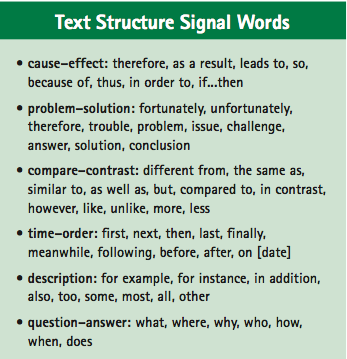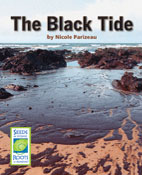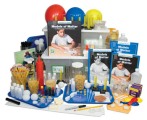Posts filed under ‘Strategy Guide’
13 Guidelines for Teaching About Posing Investigation Questions
Posing investigation questions is the foundation for learning about the natural world, and posing questions that can be investigated is an important part of scientists’ work.
This article provides guidelines that can be used to teach about posing investigation questions related to the content in many science texts. Posing an investigation involves multiple steps, including asking a question, making predictions, planning the investigation, and observing what happens. Understanding how to come up with a question to guide scientific investigation is an important inquiry skill.
When students are taught how to pose their own investigation questions, they can better understand the ways in which scientists explore the natural world and generate new knowledge.
Here are Guidelines for Investigation Questions you can provide students:
Below are 13 Guidelines for Teaching About Posing Investigation Questions related to the content in many science texts:
- Select a text about a science topic that students could potentially investigate in the classroom. Topics could include plant growth, magnets, simple chemical reactions, phase change, or rocks and minerals. Texts about particular scientific investigations can also be used for this purpose, but it is not necessary that the text specifically mention investigations.
- Create a chart on the board listing guidelines for developing investigation questions. See the box above for sample.
- Explain to the class that (more…)
11 Guidelines for Teaching with Discourse Circles
Discourse circles involve students in structured, evidence-based conversations around challenging statements. This article provides guidelines that can be used to conduct a discourse circle in conjunction with many science texts.
Here is a quick overview of how the discourse circle will work:
11 Guidelines for Teaching with Discourse Circles
- Select a text that provides evidence both for and against a statement. In science, good choices include books about human impact on the environment, books that mention scientific debates, and books about the history of science.
- Craft a statement for which students can find evidence to both support and contradict it. Write the statement on a Preparing for a Discourse Circle copymaster (PDF sample below) and make a copy for each student. The following are some guidelines to use when writing discourse-circle statements:
∙ The text must provide evidence both for and against the statement.
∙ The statement should not be obviously true or obviously false.
∙ Students should be able to choose either position without developing misconceptions about the topic.
∙ The statement should relate to important concepts in the text.Here are two examples of discourse-circle statements:
Students like us can help prevent oil from spilling in the ocean.
The stomach is the most important organ in the digestive system. - Make a class chart titled “Discourse-Circle Directions” that lists the directions for a discourse circle. (See the box above.) (more…)
Teaching Text Structure: Help Students Identify Signal Words
Text structure refers to the ways that authors organize information in a text. For example, some texts are organized as a chronological sequence of events, while others compare two or more things. Teaching students to recognize the underlying structure of content-area texts can help students focus attention on key concepts and relationships, anticipate what’s to come, and monitor their comprehension as they read.
Students can learn to identify a text’s structure by paying attention to signal words. Signal words link ideas together, show relationships, and indicate transitions from one idea to the next. Each text structure is associated with different signal words (see graphic below). Text structure can also be taught using graphic organizers, which visually represent the relationship among key ideas. Graphic organizers can be particularly helpful for English language learners and struggling readers who can use these visual tools to help understand and organize information.
Guidelines for Teaching Text Structure
- Select an appropriate text. Note that some texts may utilize more than one text structure. When introducing text structure, select a text (or portion of a text) that has one easily identifiable text structure. (more…)
Taking Notes Based on Observations with a Sky Notebook
 Elementary students need practice to learn to discern between observations and inferences. The book and Strategy Guide featured in this article gives you the tools you need to teach this important skill. When elementary students learn how to observe, they use one or more of their five senses to take notice of what otherwise might go undetected. You can help elementary students learn to record observations which involves detailed note taking. Below is information you can use to implement a note-taking strategy with your elementary students. It includes the use of a student book called Sky Notebook, but can also be used with other content readers. You’ll also find a pdf link for a FREE Strategy Guide, “Taking Notes Based on Observations“ which expands upon the information in this article.
Elementary students need practice to learn to discern between observations and inferences. The book and Strategy Guide featured in this article gives you the tools you need to teach this important skill. When elementary students learn how to observe, they use one or more of their five senses to take notice of what otherwise might go undetected. You can help elementary students learn to record observations which involves detailed note taking. Below is information you can use to implement a note-taking strategy with your elementary students. It includes the use of a student book called Sky Notebook, but can also be used with other content readers. You’ll also find a pdf link for a FREE Strategy Guide, “Taking Notes Based on Observations“ which expands upon the information in this article.
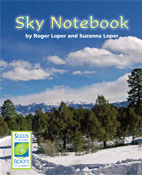 Sky Notebook is set in the mountains of Colorado where winter storms move through quickly. The narrator is an amateur meteorologist who takes measurements and keeps detailed notes to document changes in the weather. Photographs are used to illustrate these observations. National weather maps are also included; they present temperature and precipitation readings in a visual format and supplement the narrator’s observations. Readers can observe changes in the weather—such as amount of cloud cover, temperature, and humidity—as a winter storm moves in. The data presented in the book provide readers with opportunities to make predictions and inferences about the weather, not only in Colorado, but also across the United States.
Sky Notebook is set in the mountains of Colorado where winter storms move through quickly. The narrator is an amateur meteorologist who takes measurements and keeps detailed notes to document changes in the weather. Photographs are used to illustrate these observations. National weather maps are also included; they present temperature and precipitation readings in a visual format and supplement the narrator’s observations. Readers can observe changes in the weather—such as amount of cloud cover, temperature, and humidity—as a winter storm moves in. The data presented in the book provide readers with opportunities to make predictions and inferences about the weather, not only in Colorado, but also across the United States.
Students can read Sky Notebook or another content reader with detailed illustrations or photographs that prompt rich observations and lend themselves to making detailed notes. Here is a copymaster that can be used for (more…)
Helping Elementary Students See That Chemical Reactions Are Everywhere
Science labs are not the only places where chemical reactions happen. Have you ever seen bread turn brown in a toaster? If the answer is yes, you have observed a chemical reaction. The Seeds of Science/Roots of Reading® student book Chemical Reactions Everywhere, explains what a chemical reaction is and how to look for evidence of a reaction. Students learn about lots of ordinary chemical reactions that happen in our everyday lives. After reading this book, they will begin to notice chemical reactions everywhere. Below are a few of the chemical reactions featured in the book:
Fireworks explode because of chemical reactions. As they explode, fireworks produce flashes of light. The flashes are evidence that chemical reactions are happening. The reactions are giving off energy in the form of light. These reactions also give off energy in the form of heat, so fireworks are dangerous to handle.
A fresh slice of apple is usually white. Leave the slice out for a while, and it turns brown. That change is evidence of a chemical reaction! Substances in the apple combine with oxygen in the air. A chemical reaction happens, forming new substances with new properties. The new substances make the apple look brown instead of white. The change in color is evidence that a chemical reaction is happening.
Kids often carry glowing light sticks with them on the Fourth of July. To make a light stick start glowing, you bend it until it snaps. The glow happens because of a chemical reaction.
Bending the stick breaks a tube inside the stick. The tube is keeping different substances in the stick apart. When the tube breaks, the substances are able to combine, and this starts a chemical reaction. This chemical reaction gives off light, but not heat. That’s why the light sticks are safe to hold. It is important to note that light sticks have dangerous substances inside and should never be opened.
Other chemical reactions featured in the book include: (more…)
Teaching Text Structure Using Graphic Organizers and Signal Words
 Teaching elementary students to recognize the underlying structure of content-rich text can help them focus attention on key concepts and relationships, anticipate what is to come, and monitor their comprehension as they read. Below are some strategies you can employ to help students learn to identify a text’s structure by paying attention to signal words and using graphic organizers. These strategies can be used with the Seeds of Science/Roots of Reading® student booked Water in the Desert or with another appropriate content-rich text.
Teaching elementary students to recognize the underlying structure of content-rich text can help them focus attention on key concepts and relationships, anticipate what is to come, and monitor their comprehension as they read. Below are some strategies you can employ to help students learn to identify a text’s structure by paying attention to signal words and using graphic organizers. These strategies can be used with the Seeds of Science/Roots of Reading® student booked Water in the Desert or with another appropriate content-rich text.
The following guidelines can be used to teach elementary students about text structures that are common in content-rich texts: (more…)
When I grow up, I want to be a Jelly Belly scientist!
Being a scientist is cool. Being a JELLY BEAN scientist is super cool! Ambrose Lee can attest to this. Ambrose is a food scientist who brainstorms flavor recipes for gourmet jelly beans at Jelly Belly Candy Co. His job is so cool it has been featured in Popular Science magazine. Check out the Jelly Belly web site to learn more about the variety of flavors including crazy ones like: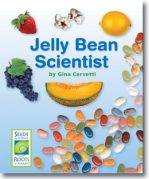
- Pencil Shavings
- Toothpaste
- Moldy Cheese
- Skunk Spray
Yuck!
The developers of the Seeds of Science/Roots of Reading program were thrilled when Ambrose agreed to be featured in a student book called Jelly Bean Scientist. In the book, readers meet Ambrose and his team of scientists who conduct tests with lab equipment and their own taste buds so the jelly bean flavors they design taste as (more…)


